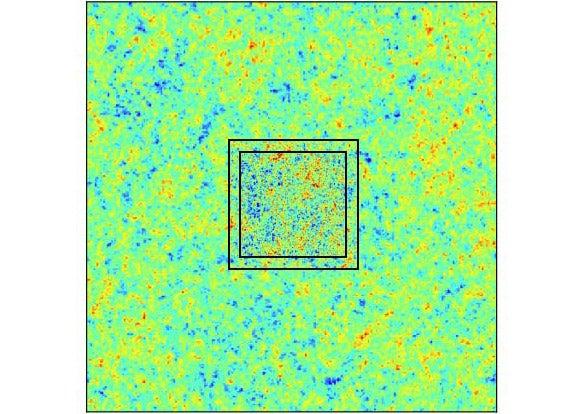The Arias of Universes in a Box
Computer simulations have become an invaluable tool to study the formation of cosmic structures over an enormous range of scales, crucial aspects of the evolution of the Universe which cannot be directly observed
By Oliver Hahn and Jack Singal
Computer simulations have become an invaluable tool to study the formation of cosmic structures over an enormous range of scales, crucial aspects of the evolution of the Universe which cannot be directly observed. Starting from tiny density perturbations that also give rise to temperature fluctuations in the cosmic microwave background radiation, simulations with computers – where millions of dark matter particles and gas cells are followed according to known physics and starting conditions – are used to study the formation of the Universe at multiple scales: the first stars at scales of a few solar radii, the formation of galaxies at scales of several thousand light years, up to the formation of entire clusters of galaxies on million-lightyear scales, and even the large-scale structure of the Universe on scales of a billion light years.
A major challenge in these cosmological simulations is to bridge the gap between large and small scales. Variations across regions in space require a large volume to be simulated to avoid basing conclusions on an atypical region, yet sufficient resolution in the single structures of interest, such as individual galaxies, to study them in detail. To meet this challenge, postdoc Oliver Hahn and Professor Tom Abel of the Kavli Institute for Particle Astrophysics and Cosmology at SLAC and Stanford have developed a new computer code named MUSIC to generate multi-scale "adaptive mesh" initial conditions that enable the study of study cosmic structure formation at very high local resolution over a large volume of space.
Using the adaptive mesh technique, the MUSIC code generates a high-resolution realization of the distribution of matter in the early universe in a small region of space; the matter outside of this region of interest is sampled at much coarser resolution, while still allowing a full accounting of any effects on more densely sampled regions of interest. Such multi-scale initial conditions allow simulations to focus computational resources in the subsequent evolution of the primordial fluid of baryonic gas and dark matter on the region where an object of interest – be it a first star, a galaxy or a galaxy cluster – will form.
Compared to previous approaches, MUSIC produces multi-scale initial conditions with significantly reduced errors – typically two orders of magnitude lower – and runs with a very low memory footprint, enabling future simulations with greatly increased resolution and accuracy in the initial conditions. This will allow researchers to face the challenges of simulating both precision cosmology, to accurately study the evolution of our Universe, and high-resolution astrophysics of the formation of objects such as galaxies and galaxy clusters.
Understanding these objects' formation and evolution is of key importance for observational efforts that aim to measure the effect of dark energy on cosmic evolution and thereby reveal its nature. Furthermore, studying the formation of galaxies with increasingly sophisticated simulations enables researchers to study in detail the physical processes relevant for their assembly and subsequent evolution.
